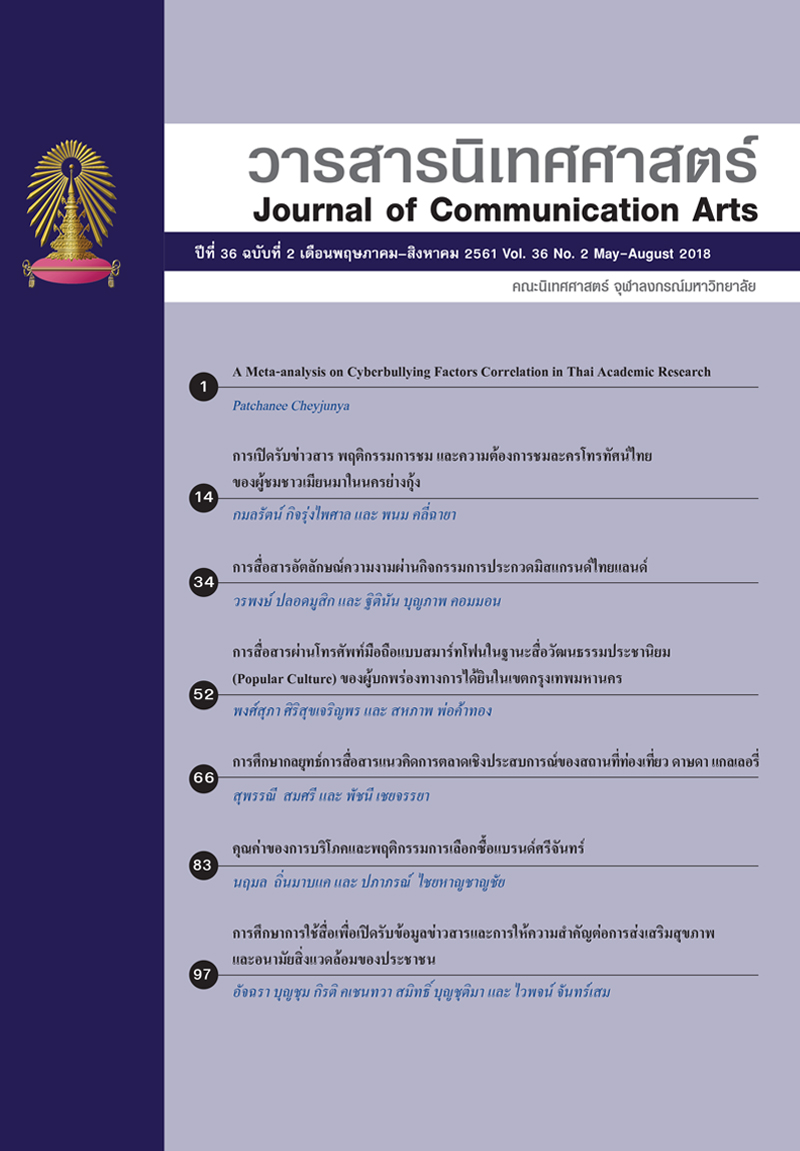การศึกษาการใช้สื่อเพื่อเปิดรับข้อมูลข่าวสารและการให้ความสำคัญต่อการส่งเสริมสุขภาพและอนามัยสิ่งแวดล้อมของประชาชน
Main Article Content
Abstract
The objectives of this research were tostudy: 1) media which all age groups exposed information and knowledge regarding health promotion and environmental health; 2) types of information and knowledge regarding health promotion and environmental health which all age groups exposed; 3) Emphasizing on health promotion of all age groups. The quantitative research methodology was conducted, as well as survey research method to collect data from the samples comprising of 5 age groups: 1) mothers and children group, 2) young student group, 3) teenage group, 4) working group and 5) elderly groups. There are 2,539 samples in 5 regions of Thailand, including Bangkok, NakhonPathom, Chiang Mai, NakhonRatchasima and Songkhla.
The findings found that the majority of the youth and working-age were exposed to information and knowledge related to health promotion and environmental health through the internet, followed by the television. Elder people were most exposed to television media. All age groups were interested in information and knowledge about food cleanliness and safety. However, all age groups were exposed to sex, education, and life skills at the lowest level. The findings from this research illustrated that all age groups put an importance on the health, mostly to health care in food. Meanwhile, the student, teenage, and working groups paid more attention to oral health, mother and children cared for the environmental health and elder people focused on exercise.
Article Details
References
กรมควบคุมโรค, สำนักสื่อสารความเสี่ยงและพัฒนาพฤติกรรมสุขภาพ. (2554). การประเมินผลการรับรู้ข้อมูลข่าวสารและสำรวจพฤติกรรมประชาชน ปี 2554.สืบค้นจาก http://goo.gl/gfWP3I.
กรมควบคุมโรค,สำนักสื่อสารความเสี่ยงและพัฒนาพฤติกรรมสุขภาพ. (2557). การสำรวจการรับทราบข้อมูลข่าวสารความรู้และพฤติกรรมของคนไทยและภาพลักษณ์ของกรมควบคุมโรคปี 2557. สืบค้นจาก http://goo.gl/r4Pcps.
กระทรวงสาธารณสุข, กรมควบคุมโรค. (2557).การสำรวจการรับทราบข้อมูลข่าวสาร ความรู้ของ
ประชาชนไทย และภาพลักษณ์กรมควบคุมโรค ปี 2557. นนทบุรี: กรมควบคุมโรค กระทรวงสาธารณสุข.
กระทรวงสาธารณสุข, กรมควบคุมโรค. (2558). รายงานการสำรวจการรับทราบข้อมูลข่าวสาร ความรู้
และพฤติกรรมสุขภาพของประชาชนไทยและความพึงพอใจต่อการสื่อสารความเสี่ยงของกรมควบคุมโรค ประจำปี 2558.นนทบุรี: กรมควบคุมโรค กระทรวงสาธารณสุข.
กระทรวงสาธารณสุข, กรมอนามัย (2560). แผนยุทธศาสตร์การพัฒนาระบบส่งเสริมสุขภาพและ
อนามัยสิ่งแวดล้อม ตามแผนพัฒนาสุขภาพแห่งชาติ ในช่วงแผนพัฒนาเศรษฐกิจและสังคมแห่งชาติ ฉบับที่ 12 พ.ศ.2560-2564. นนทบุรี: กรมอนามัย กระทรวงสาธารณสุข.
กระทรวงสาธารณสุข, กรมอนามัย. (2553). แผนยุทธศาสตร์กรมอนามัย พ.ศ.2553-2556.นนทบุรี: กรมอนามัย กระทรวงสาธารณสุข.
กาญจนา แก้วเทพ. (2556). สื่อสารมวลชน: ทฤษฎีและแนวทางการศึกษา(พิมพ์ครั้งที่ 4).
กรุงเทพฯ: เอดิสัน เพรส โพรดักส์
จินตนาพัฒนพงศ์ธร, ชัยชนะบุญสุวรรณ, และนฤมลธนเจริญวัชร. (2558). รายงานการศึกษา
พัฒนาการเด็กปฐมวัยไทยปี 2557.สำนักส่งเสริมสุภาพ. นนทบุรี.
ฐานเศรษฐกิจ. (2559, 10 มีนาคม). ความท้าทายของคนหนังสือพิมพ์.ฐานเศรษฐกิจ,น. 138.
ไปรยา ตันติวงศ์. (2541). กลยุทธ์การแข่งขันของนสพ.บางกอกโพสต์และเดอะเนชัน ผ่านการจัดทํานิตยสารแทรก Real Time และ Weekend กับการใช้ประโยชน์และความพึงพอใจของผู้รับสาร(วิทยานิพนธ์ปริญญามหาบัณฑิต). จุฬาลงกรณ์มหาวิทยาลัย, กรุงเทพฯ.
รัตติยา อังกุลานนท์. (2559, 17 กุมภาพันธ์). ‘ทีวี-สมาร์ทโฟน’ จอหลักเสพสื่อ. กรุงเทพธุรกิจออนไลน์. สืบค้นจาก http://www.bangkokbiznews.com/blog/detail/636947.
สถาบันวิจัยประชากรและสังคม. (2558, 15 มีนาคม). รายงานสุขภาพคนไทย. สืบค้นจาก
http://www.thaihealthreport.com/policybrief.
สราวุฒิบุญสุข,และนงลักษณ์รุ่งทรัพย์สิน. (2558). การศึกษาการตายของมารดาไทยปี 2556.
นนทบุรี: สำนักส่งเสริมสุขภาพ กรมอนามัย.
สำนักงานคณะกรรมการพัฒนาเศรษฐกิจและสังคมแห่งชาติ. (2555). สถิติสาธารณสุข สำนักนโยบายและยุทธศาสตร์กระทรวงสาธารณสุข 2546-2554.สืบค้นจาก
http://www.thaihealthreport.com/policybrief.
สำนักข่าวออนไลน์ไทยพับลิก้า. (2559, 29 มกราคม). อุตสาหกรรมสิ่งพิมพ์ไทย “นิตยสาร” ปิดตัว เปลี่ยนเวที – “หนังสือพิมพ์“ ทรงกับทรุด – งานหนังสือยอดขายลด 25%.สืบค้นจาก http://thaipublica.org/2016/01/print-1/.
สํานักงานพัฒนาระบบข้อมูลข่าวสารสุขภาพ. (2557). รายงานด้านสถานะสุขภาพโดยรวม. สืบค้นจาก http://hiso.or.th/healthpromotion.
สำนักงานพัฒนานโยบายสุขภาพระหว่างประเทศ. (2556). รายงานภาระโรคจากปัจจัยเสี่ยงของประชากรไทย. สืบค้นจาก http://ihppthaigov.net/DB/publication/publication_research_show
.php?id=331.
สถาบันวิจัยประชากรและสังคม, สำนักงานกองทุนสนับสนุนการสร้างเสริมสุขภาพ, และสำนักงานคณะกรรมการสุขภาพแห่งชาติ. (2557). สุขภาพคนไทย 2557: ชุมชนท้องถิ่นจัดการตนเอง…สู่การปฏิรูปประเทศจากฐานราก (พิมพ์ครั้งที่ 1).นครปฐม: สถาบันวิจัยประชากรและสังคม มหาวิทยาลัยมหิดล.
อาร์วายทีไนน์. (2556, 25 มกราคม) Health & Wellness 2013มายด์แชร์เผยคนไทยใส่ใจสุขภาพแต่ใช้ชีวิตสวนทาง. สืบค้นจาก http://www.ryt9.com/s/prg/1576148.
อินโฟเควสท์. (2561).แนวโน้มสื่อในประเทศไทยปี 2561.สืบค้นจาก http://blog.infoquest.co.th/iqmedialink/free-download-thailand-media-landscape-2018/.
เอกชัย เพียรศรีวัชรา, และวิมล บ้านพวน. (2557). รายงานการสำรวจสุขภาวะผู้สูงอายุไทยปี 2556
ภายใต้แผนงานส่งเสริมสุขภาพผู้สูงอายุและผู้พิการ. สืบค้นจาก
http://www.hitap.net/documents/24067.
ภาษาอังกฤษ
CAMI. (2015, July 5). Developing communication strategy - advantages and disadvantages of different types of media.Retrieved from: http://goo.gl/IGdWbN.
Cheyjunya, P. (2016). Structural equation model of Thai’s elderly adoption ofcommunication technology.Journal of Communication Arts Review, 19(2), 85-100.
Katz, E. &Lazarsfeld, P. F. (1955).Personal influence. New York, NY: The Free Press of Glencoe
Klapper, J. T. (1960). The effects of communications.New York, NY: Free Press. Population Communication Services, Johns Hopkins Bloomberg School of Public.
Health/Center for Communication Program. (2015, June 30).A field guide to designing a health communication strategy: A resource for health communication professionals. Retrieved from: http://goo.gl/BCYEzT.
Severin, W. J. & Tankard, J. W. (1992).Communication theories: Origins, methods, and uses in the mass media(3rd ed.) New York, NY: Longman.
Shira, H. F., Daniel, D., Bredley, H. C., Meghan, D., & Charles, H. (2014).Acceptanceand use of health information technology by community-dwelling elders.International Journal of Medical Informatics, 83(2014), 624-635.
Yamane, T. (1973).Statistics: An introductory analysis. New York, NY: Harper & Row.


